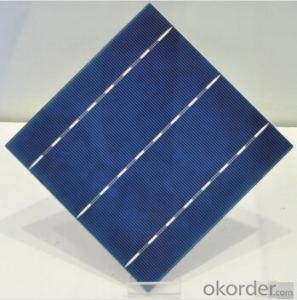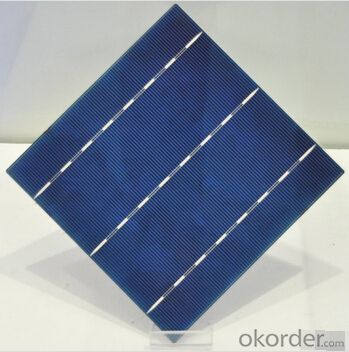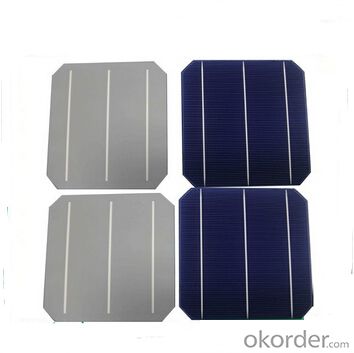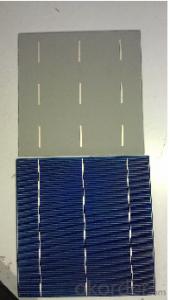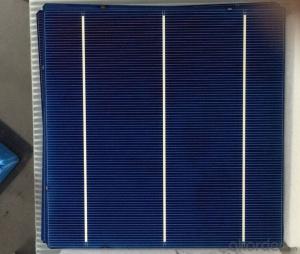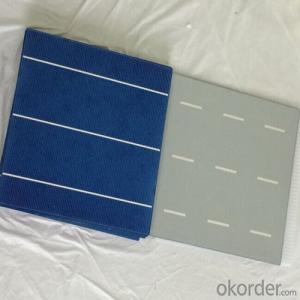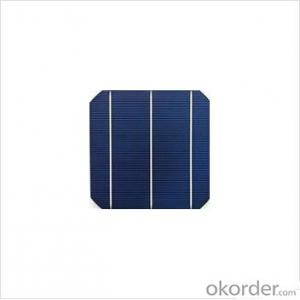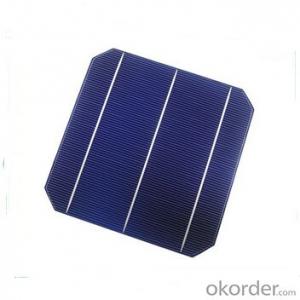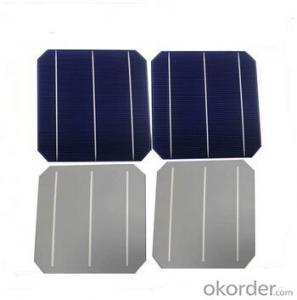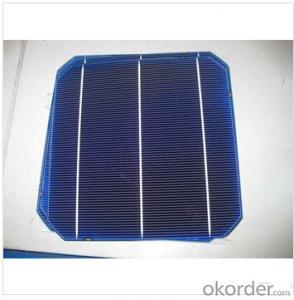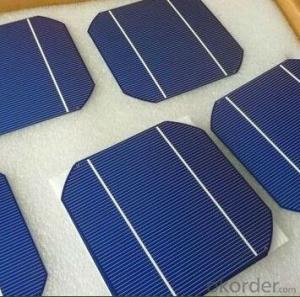Sunpower C60 Monocrystalline Solar Cells High Quality 15.6-18
- Loading Port:
- Shanghai
- Payment Terms:
- TT OR LC
- Min Order Qty:
- 1000 pc
- Supply Capability:
- 1000000 pc/month
OKorder Service Pledge
OKorder Financial Service
You Might Also Like
Solar Cells:
Solar cells is made by solar wafer, it has three categories of solar cell right now, monocrystalline polycrystalline and thin film,These cells are entirely based around the concept PNjunction, which is the critical part of solar module, it is the part that can convert the light energy into electricity, the thickness is from 180um to 200um, with even busbars to conduct electricity, textured cell can decrease diffuse reflection; they are often electrically connected and encapsulated as a module. Photovoltaic modules often have a sheet of glass on the front (sun up) side, allowing light to pass while protecting semiconductor wafers from abrasion and impact due to wind-driven debris, rain, hail, etc. Solar cells are also usually connected in series in modules, creating an additive voltage. Connecting cells in parallel will yield a higher current;With high quality and stable quality. Our Cells can greatly improve the performance of Solar Modules.
Features:
1. High conversion efficiencies resulting in superior power output performance.
2. Outstanding power output even in low light or high temperature conditions
3. Optimized design for ease of soldering and lamination
4. Long-term stability, reliability and performance
5. Low breakage rate
6. Color uniformity
Solar Cells Advantage:
• High efficiency and stable performance in photovoltaic conversion.
• Advanced diffusion technique ensuring the homogeneity of energy conversion efficiency of the cell.
• Advanced PECVD film forming, providing a dark blue silicon nitride anti-reflection film of homogenous color and attractive appearance.
• High quality metal paste for back surface and electrode, ensuring good conductivity, high pulling strength and ease of soldering.
• High precision patterning using screen printing, ensuring accurate busbar location for ease with automatic soldering a laser cutting.
Specifications:
Diagonal: | 220mm±0.5mm | |||||||||||
Thickness(Si): | 200±20 μm | |||||||||||
Front(-) | Blue anti-reflecting coating (silicon nitride); | |||||||||||
1.5mm wide bus bars; | ||||||||||||
Distance between bus bars: 51mm . | ||||||||||||
Back(+) | Aluminum back surface field; | |||||||||||
2.0mm wide soldering pads; | ||||||||||||
Distance between bus bars :51mm . | ||||||||||||
| ||||||||||||
Electrical Characteristics Efficiency(%) | 18 | 17.8 | 17.6 | 17.4 | 17.2 | 16.8 | 16.6 | 16.4 | 16.2 | 16 | 15.8 | 15.6 |
Pmpp(W) | 4.33 | 4.29 | 4.24 | 4.19 | 4.14 | 4.09 | 4.04 | 3.99 | 3.94 | 3.9 | 3.86 | 3.82 |
Umpp(V) | 0.53 | 0.527 | 0.524 | 0.521 | 0.518 | 0.516 | 0.514 | 0.511 | 0.509 | 0.506 | 0.503 | 0.501 |
Impp(A) | 8.159 | 8.126 | 8.081 | 8.035 | 7.99 | 7.938 | 7.876 | 7.813 | 7.754 | 7.698 | 7.642 | 7.586 |
Uoc(V) | 0.633 | 0.631 | 0.628 | 0.625 | 0.623 | 0.62 | 0.618 | 0.617 | 0.615 | 0.613 | 0.611 | 0.609 |
Isc(A) | 8.709 | 8.677 | 8.629 | 8.578 | 8.531 | 8.478 | 8.419 | 8.356 | 8.289 | 8.22 | 8.151 | 8.083 |
Packaging & Delivery of Solar Cells
Carton Box Package and Deliver by air. It should be noticed that it should be avoid of water, sunshine and moist.
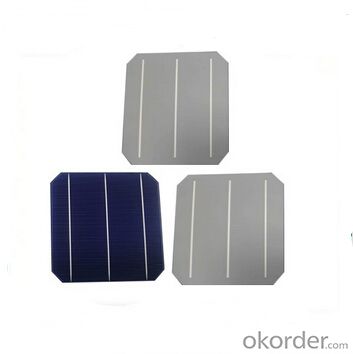
FAQ
We have organized several common questions for our clients,may help you sincerely:
①What price for each watt?
It depends on the efficiency of the solar cell, quantity, delivery date and payment terms.
②How long can we receive the product after purchase?
In the purchase of product within three working days, We will arrange the factory delivery as soon as possible. The pecific time of receiving is related to the state and position of customers.Commonly 7 to 10 working days can be served.
③Can you provide the peripheral products of the solar panels, such as the battery, controller, and inverter? If so, can you tell me how do they match each other?
Yes, we can, we have two companies for solar region, one is CNBM International, the other is CNBM engineering Co.
We can provide you not only the solar module but also the off grid solar system, we can also provide you service with on grid plant.
④What is your warranty of solar cell?
Our product can promise lower than 0.3% open box crack, we support claim after opening the box if it has crackm color difference or sth, the buyer should give pictures immediately, we can not accept the claim after the solar cell has assembled to solar panel.
• Timeliness of delivery
• ⑤How do you pack your products?
We have rich experience on how to pack the solar cell to make sure the safety on shipment, we could use wooden box or pallet as buyer's preference.
- Q: How do solar cells generate electricity?
- Solar cells generate electricity through the photovoltaic effect, where the cells convert sunlight directly into electrical energy. The cells are made of semiconducting materials, usually silicon, which absorb photons from the sunlight. These photons excite the electrons in the material, causing them to break free from their atoms and create an electric current. This current is then collected and used to power various devices or stored in batteries for later use.
- Q: Can solar cells be damaged by hail or other weather events?
- Yes, solar cells can be damaged by hail or other severe weather events. Hailstones can potentially crack or shatter the surface of the solar panels, affecting their efficiency and functionality. Similarly, extreme weather events like hurricanes or heavy storms can cause physical damage by dislodging or breaking the panels, leading to a decrease in their performance. It is important to ensure proper installation and maintenance to minimize the risk of weather-related damage to solar cells.
- Q: What is the role of power optimizers in solar cell systems?
- The role of power optimizers in solar cell systems is to maximize energy production by individually optimizing the output of each solar panel. They ensure that each panel operates at its maximum efficiency, regardless of shading or mismatch in the system. This results in higher overall energy yields, improved system performance, and enhanced safety by reducing the risk of fire hazards or other issues caused by reduced voltage.
- Q: What is a polycrystalline solar cell?
- A polycrystalline solar cell is a type of solar cell made from multiple crystal structures, resulting in a grainy appearance. It is less expensive to produce compared to monocrystalline cells, but typically has lower efficiency levels.
- Q: Can solar cells be used in boats or marine applications?
- Yes, solar cells can definitely be used in boats or marine applications. They provide a sustainable and renewable source of energy to power various systems onboard, such as navigation equipment, lighting, battery charging, and even propulsion systems. Solar panels can be installed on the deck or roof of a boat, where they can harness the sun's energy to generate electricity and reduce reliance on fossil fuels.
- Q: Can solar cells be used in sports stadiums or arenas?
- Yes, solar cells can certainly be used in sports stadiums or arenas. They can be installed on the rooftops, canopies, or surrounding areas to harness solar energy and generate electricity, thereby reducing the reliance on traditional power sources. This sustainable energy solution can help stadiums and arenas become more environmentally friendly and potentially offset their energy costs.
- Q: My solar cells are broken, can I just buy one and replace it?
- You need to hire a professional to fix that for you.
- Q: What materials are commonly used to make solar cells?
- Silicon is the most commonly used material for making solar cells. Other materials, such as cadmium telluride, copper indium gallium selenide, and perovskite, are also used in certain types of solar cells.
- Q: How much does a solar cell cost?
- Figuring out exactly the cost of the solar system you have can take a little detective work.
- Q: Can solar cells be used for water heating?
- Yes, solar cells can be used for water heating. Solar thermal panels, also known as solar water heaters, use solar cells to convert sunlight into heat energy, which is then used to heat water for various applications such as domestic hot water or space heating.
Send your message to us
Sunpower C60 Monocrystalline Solar Cells High Quality 15.6-18
- Loading Port:
- Shanghai
- Payment Terms:
- TT OR LC
- Min Order Qty:
- 1000 pc
- Supply Capability:
- 1000000 pc/month
OKorder Service Pledge
OKorder Financial Service
Similar products
Hot products
Hot Searches
Related keywords
